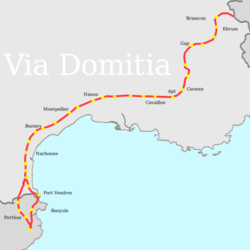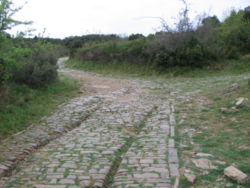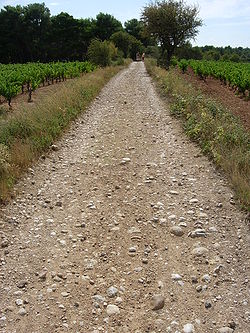- Via Domitia
-
The Via Domitia was the first Roman road built in Gaul, to link Italy and Hispania through Gallia Narbonensis, across what is now southern France. The route that the Romans regularised and paved was ancient when they set out to survey it, so old that it traces the mythic route travelled by Heracles.[1] Hannibal traversed it on his way from Hispania to Italy.
It was constructed in 118 BC by the proconsul, Gnaeus Domitius Ahenobarbus, whose name it bore; it was built around the same time the first Roman colony in Gaul, Colonia Narbo Martius (Narbonne) was founded. The Via Domitia connected Italy to Hispania. Crossing the Alps by the easiest passage, the Col de Montgenèvre (1850 m), it followed the valley of the Durance, crossed the Rhône at Beaucaire passed through Nîmes (Nemausus) then followed the coastal plain along the Gulf of Lion. At Narbonne, it met the Via Aquitania (which led toward the Atlantic Ocean through Toulouse and Bordeaux). Thus Narbonne was a crucial strategic crossroads of the Via Domitia and the Via Aquitania, and it was an accessible, but well-defendable, port at that time. This "cusp point" in the Roman westwards expansion and ensuing supply, communication and fortification was a very important asset, and was treated as such (see Narbonne). In between the cities that it linked, the Via Domitia was provided with a series of mansiones at distances of a day's journey for a loaded cart, at which shelter, provender and fresh horses could be obtained for travellers on official business.
The route as it was in Late Antiquity is represented in schematic fashion on the Tabula Peutingeriana.
Contents
Route
This route can be traced on topographical maps overprinted with the ancient route, in G. Castellve, J.-B. Compsa, J. Kotarba and A. Pezin, eds. Voies romaines du Rhône à l'Èbre: Via Domitia et Via Augusta (DAF 61) Paris 1997.
- Briançon (Brigantio)
- Chorges (Caturigomagus)
- Gap (Vapincum)
- Le Monetier Allemont (Alabons)
- Embrun (Eburodunum)
- Sisteron (Segustero)
- Lurs (Alaunium)
- Céreste (Catuiacia)
- Apt (Apta Julia)
- Notre Dame des Lumières (Ad Fines)
- Cavaillon (Cabellio)
- Saint-Rémy-de-Provence (Glanum)
- Saint-Gabriel (Ernaginum)
- Beaucaire (Ugernum)
- Nîmes (Nemausus)
- Ambrussum
- Lunel-Vieil
- Castelnau-le-Lez (Sextantio)
- Montpellier route remains unknown
- Montbazin (Forum Domitii)
- Mèze
- Pinet
- Saint-Thibéry (Cessero) and its Roman bridge
- Béziers (Baeterris)
- Narbonne (Narbo Martius) At Narbonne, a section of the Via Domitia is exposed in the Place de l'Hôtel de Ville. The Via Domitia crossed the Atax (the Aude) by a seven-arched bridge at the site of the Pont des Marchands.[2]
- Fitou (Ad Viscensimum)
- Salses (Ad Salsulae)
- Perpignan
- Ruscino
At Ruscino, the road separates in two: the Inland Route and the Coastal Route, which rejoin at La Junquera.
Coastal Route
- Elne (Illiberis)
- Saint-Cyprien
- Argelès
- Collioure
- Port-Vendres (Portus Veneris)
- Banyuls
Inland Route
- Montescot
- Le Boulou
- Les Cluses (Clausurae)
- Le Perthus (Col de Panissars), at the Trophy of Pompey
Rejoins at:
- La Junquera (Deciana)
Here the Via Augusta begins.
Roman bridges
- For an overview of the location of Roman bridges, see List of Roman bridges.
There are the remains of several Roman bridges along the road, including the Roman Bridge of Saint-Thibéry, the Pont Ambroix at Ambrussum, the Pont Julien and the Pont Serme.
Notes
- ^ F. Benoît, "La légende d'Héraclès et la colonisation grecque dans le delta du Rhône", L'Humanité 8 (1949:104-48), noted by Fred S. Kleiner, "Gallia Graeca, Gallia Romana and the Introduction of Classical Sculpture in Gaul" American Journal of Archaeology 77.4 (October 1973:379-390) p. 381 note 20, with further bibliography.
- ^ Narbonne: Remains of the Domitian Way
See also
Bibliography
- Raymond Chevalier, Les Voies Romaines, Picard, Paris, 1997. ISBN 2-7084-0526-8
- Pierre A. Clement and Alain Peyre, La Voie Domitienne: De la Via Domitia aux routes de l'an 2000, Presses du Languedoc/Max Chaleil Editeur, 1992. ISBN 2-85998-097-0
- Pierre A. Clement, La Via Domitia: Des Pyrénées aux Alpes, Editions Ouest-France, Rennes, 2005. ISBN 2-7373-3508-6
External links
- "Suivez la Via Domitia" DVD 60 mins. English - French - German
- Via Domitia
- Luberon News - Via Domitia (French)
- Traces of the Via Domitia
- Ambrussum
- St Thibery - Via Domitia
Roman Empire – Roman roads Via Aemilia – Via Aemilia Scauri – Via Agrippa – Via Amerina – Via Anicia – Via Appia – Via Aquillia – Via Aquitania – Via Asturica Burdigalam – Via Augusta – Via Augusta Pretoria – Via Aurelia – Via Bracara Asturicam – Via Campana – Via Cassia – Via Claudia Augusta – Via Claudia Nova – Via Clodia – Via Confluentana – Via Corsica – Via Decia – Via Delapidata – Via Devana – Strata Diocletiana – Via Domitia – Via Domiziana – Via Egnatia – Via Fenollentis – Via Flaminia – Via Flavia – Via Gallica – Via Gemina – Via Hadriana – Via Julia Augusta – Via Labicana – Via Latina – Via Laurentina – Via Lusitanorum – Via Mala – Via Maris – Via Militaris – Via Nomentana – Via Ostiensis – Via Pontica – Via Popilia – Via Portuensis – Via Praenestina – Via Postumia – Via Salaria – Via Severiana – Via Sublacensis – Via Traiana – Via Traiana Nova – Via Valeria – Via Vallespiri
Categories:- Archaeological sites in France
- Roman roads in Gaul
- Narbonne
Wikimedia Foundation. 2010.







